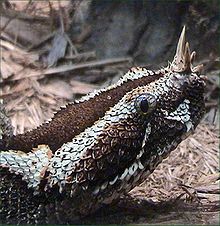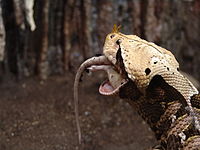Puff adders
| Puff adders | ||||||||||||
|---|---|---|---|---|---|---|---|---|---|---|---|---|

Puff adder ( Bitis arietans ) |
||||||||||||
| Systematics | ||||||||||||
|
||||||||||||
| Scientific name | ||||||||||||
| Bitis | ||||||||||||
| Gray , 1842 |
The puff adders ( Bitis ) are a genus of venomous snakes from the family of vipers (Viperidae ) that are found exclusively in Africa and southern Arabia , with currently 18 known species.
The type species is the puff adder ( Bitis arietans ) widespread in Africa . It is named after the typical threatening gestures and noises that the animals produce when threatened. The snakes puff up and release the air in loud hissing and popping noises ("puffs").
features
The puff adders include the Gaboon viper ( Bitis gabonica ) with a body length of up to two meters, one of the best-known and largest vipers worldwide, at the same time the genus also contains the smallest vipers, such as the miniature puff adder ( Bitis peringueyi ) with only about 30 centimeters or the Schneider's miniature puff adder ( Bitis schneideri ), with a body length of 19 to a maximum of 28 centimeters. Most species are relatively clumsy.
Characteristic of all species is a broad, triangular head with a rounded snout, which is clearly separated from the body and covered with small, clearly keeled scales. The angle between the top of the head and the sides of the head as well as the rostral , the so-called canthus , is very sharp. In many species there are enlarged over-eye shields ( supraoculars ) or nasal shields ( rostrals ) that form horns. For example, the rhinoceros viper ( B. nasicornis ) and the Gabon viper ( B. gabonica ) have a distinct nasal horn and the horned puff adder ( B. caudalis ) and the tufted brow adder ( B. cornuta ) have pronounced horns above the eyes.
The eyes are relatively small and in most species are on the sides of the body, the nostrils are large and often point upwards. The rostral and nasal are separated from each other by 0 to 6 scales. The maxillary bones are short and have only a pair of curved poison teeth .
The body is covered with strongly keeled and toothed scales, the scales are often slightly curved on the sides of the body. In the middle of the body the number of scales varies between the species in the range from 21 to 46. The ventral scales ( ventral ) are large and rounded, it is 112 to 146 depending on the species considered. In some species they are slightly keeled, but mostly smooth . The anal is undivided, followed by 16 to 37 paired sub- caudal scales , which can also be keeled.
distribution and habitat
The puff adders inhabit a large part of the African continent and part of the Arabian Peninsula . Almost all habitats are colonized by them. For example, the dwarf puff adder ( B. peringueyi ) can be found as a distinct desert species exclusively in the Namib Desert, while the Gaboon viper ( B. gabonica ) lives in the jungle areas of West Africa. The puff adder ( B. arietans ) is most widespread and can be found on the entire African continent as well as the only species on the Arabian Peninsula with the exception of extreme habitats. In contrast, other species such as the Ethiopian puff adder ( B. parviocula ) live as Endemic to very limited areas.
Way of life
Puff adders are all ground-dwelling snakes, only individual species can also climb. The large species of the genus in particular move slowly crawling, smaller species snake or can move sideways .
Although most species appear slow and sluggish, they can snap shut very quickly when a potential prey approaches them. They all feed on smaller mammals and lizards, depending on their own body size. Common to the species is the threatening behavior that gives them their name. The snakes puff up and release the air in loud hissing and popping noises (English "puffs"), this can last for a very long time, especially with the large species.
All puff adders are viviparous ( viviparous ) and can sometimes very give birth to large numbers of young snakes.
Hybrids of Bitis arietans and Bitis gabonica as well as Bitis gabonica and Bitis nasicornis have already been detected where their distribution areas overlap .
Systematics

There are currently 18 species of puff adders:
- Bitis albanica
- Puff adder ( Bitis arietans )
- Bitis armata
- Mountain puff adder ( Bitis atropos )
- Horned puff adder ( Bitis caudalis )
- Tuft-browed puff adder ( Bitis cornuta )
- Eastern gabon viper ( Bitis gabonica )
- Bitis harenna
- Angola puff adder ( Bitis heraldica )
- Highland puff adder ( Bitis inornata )
- Rhinoceros viper ( Bitis nasicornis )
- Ethiopian puff adder ( Bitis parviocula )
- Dwarf puff adder ( Bitis peringueyi )
- Western Gaboon Viper ( Bitis rhinoceros )
- Bitis rudiba
- Schneider's miniature puff adder ( Bitis schneideri )
- Kenya puff adder ( Bitis worthingtoni )
- Desert puff adder ( Bitis xeropaga )
In addition, Bitis olduvaiensis is an extinct puff adder species.
Snake venom
All types of puff adders are poisonous and have very different effective poisons and amounts of poison depending on the species. Like most snake venom, the poison of the puff adder is a mixture of different proteins, which have different effects in the body of the prey or a bitten person. Most of the puff adder venom has a hemolytic effect .
supporting documents
- ↑ Chris Mattison: Encyclopedia of the snakes , blv publishing house. ISBN 978-3-8354-0360-4 .
- ↑ according to ITIS
- ↑ JC Rage: Fossil snakes from Olduvai, Tanzania. In: LSB Leakey, RJB Sauvage, SC Coryndon (eds.): Fossil Vertebrates from Africa, Vol. 3. Academic Press, London 1973.
literature
- David Mallow, David Ludwig, Göran Nilson: True Vipers. Natural History and Toxicology of Old World Vipers. Krieger Publishing Company Malabar, Florida, 2003: pp. 59-129. ISBN 0-89464-877-2
